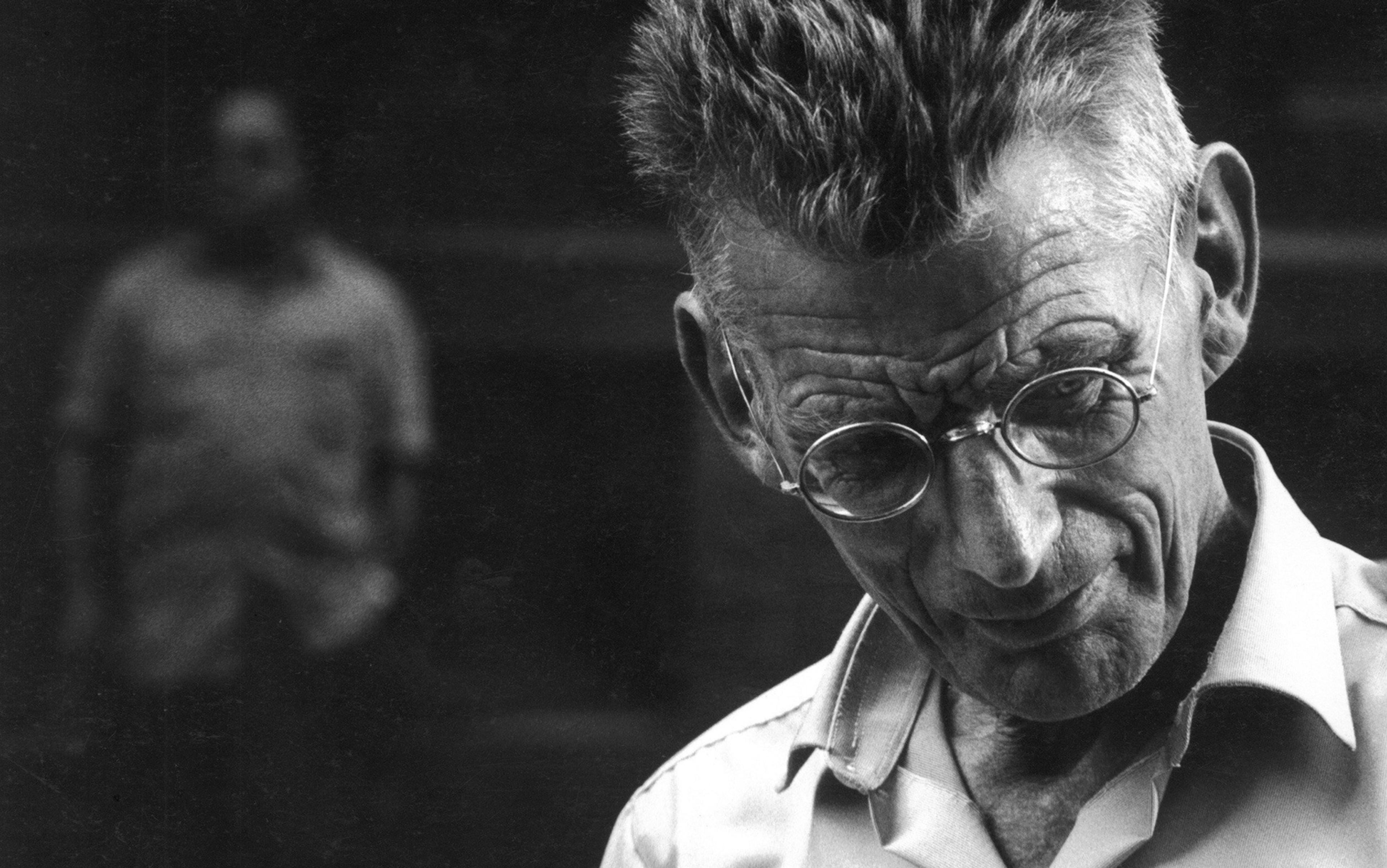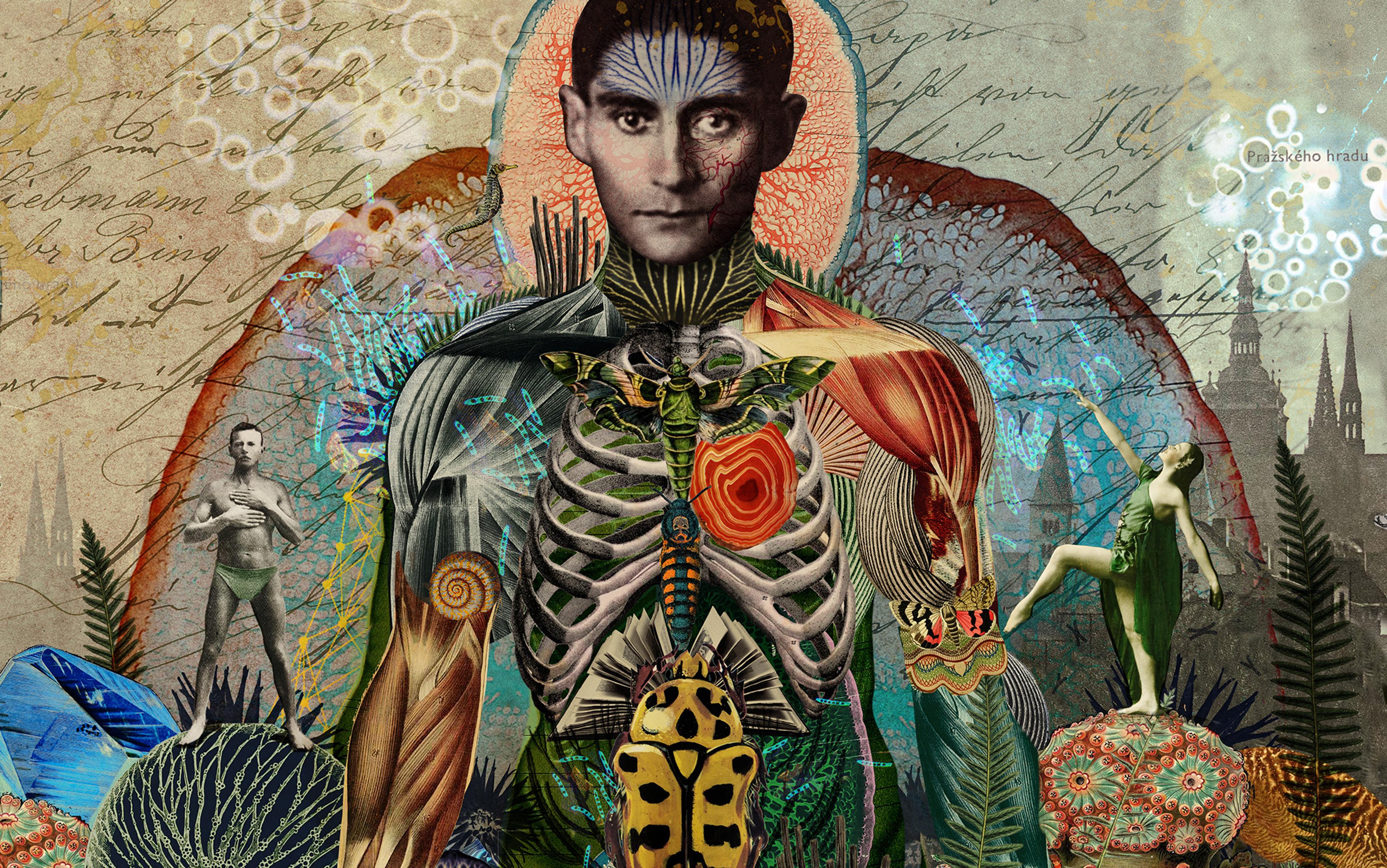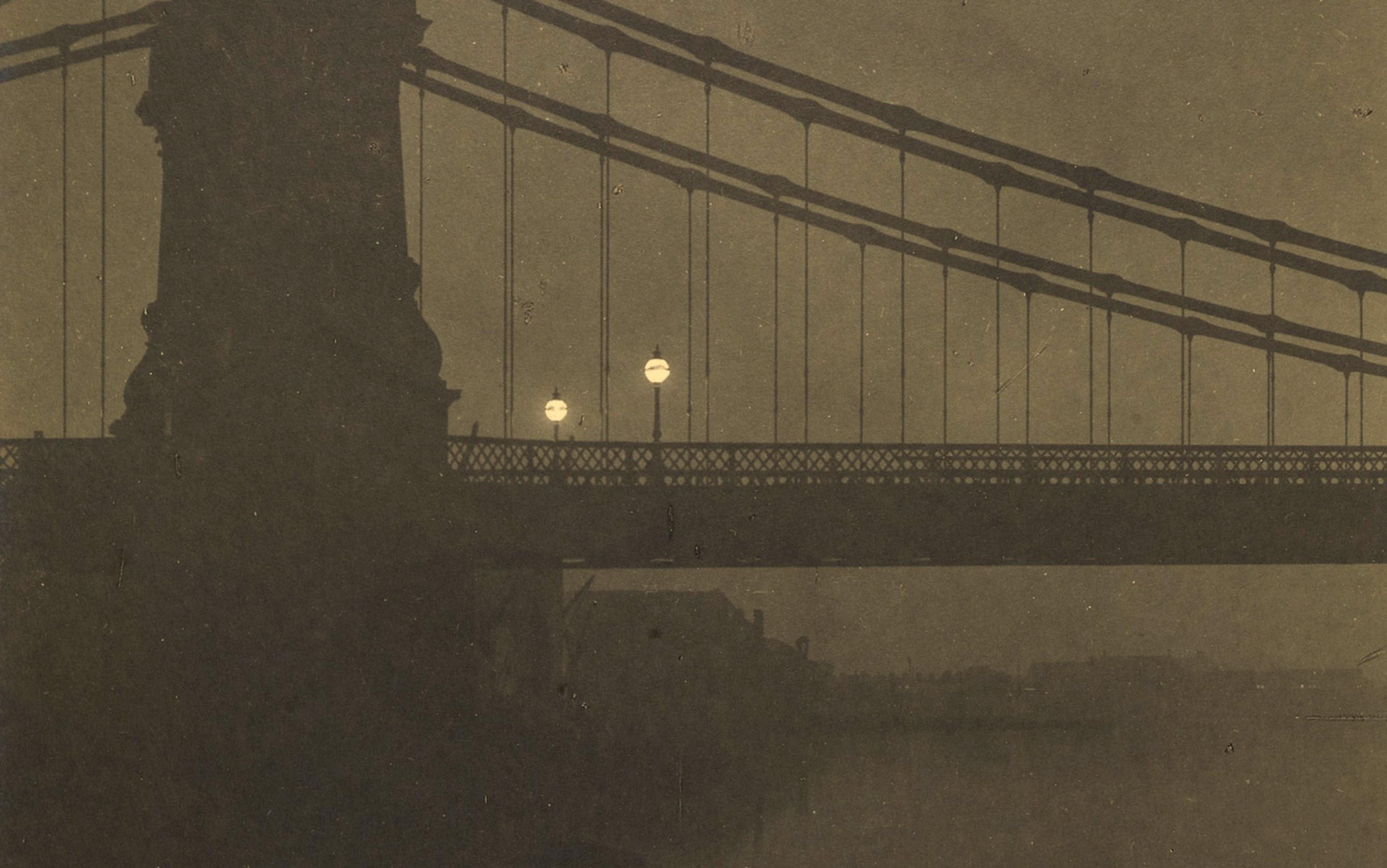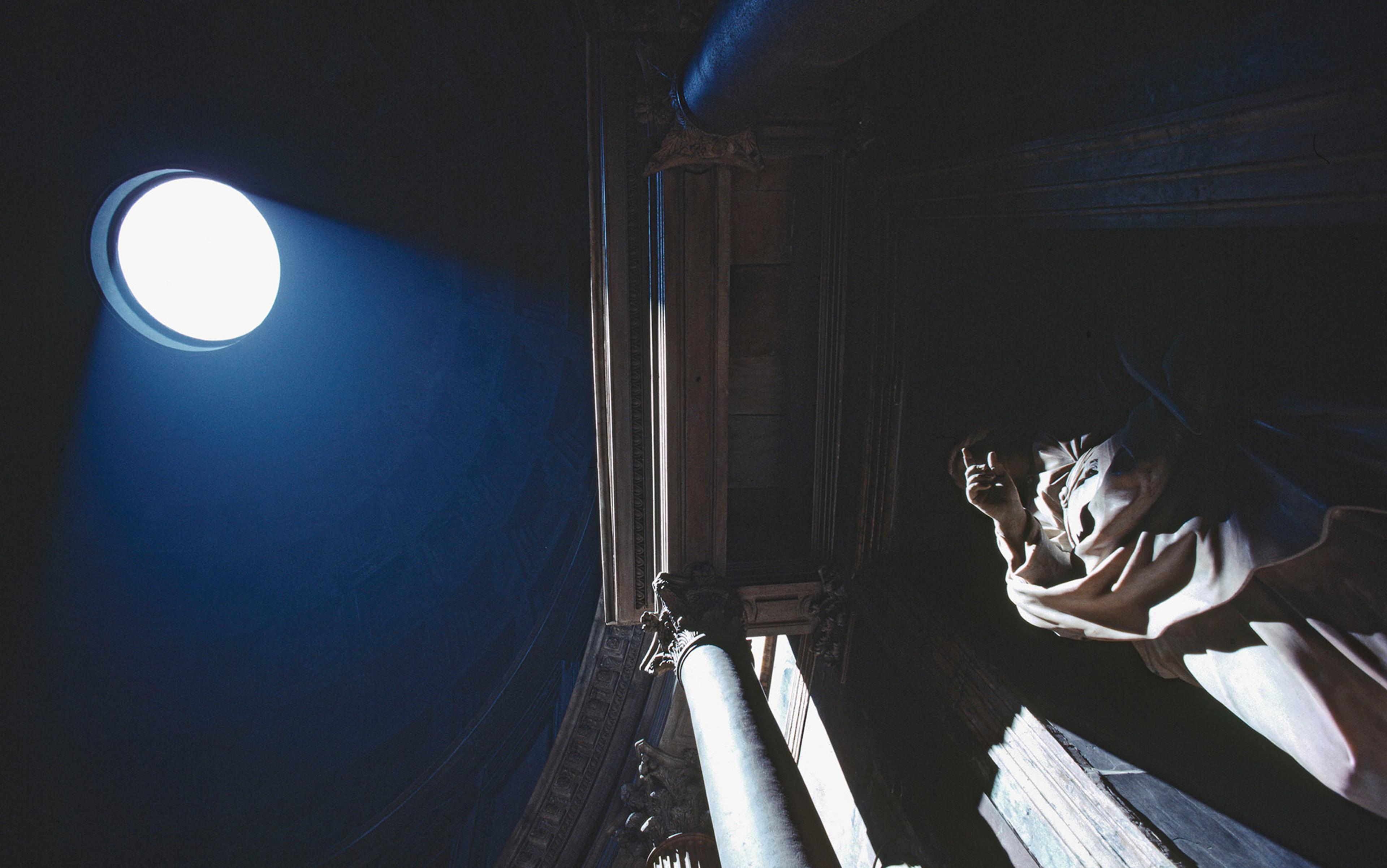Samuel Beckett’s writing often seems to have a religious air about it. Take his most famous play, Waiting for Godot (1953). Two Chaplinesque tramps – Vladimir and Estragon – wait at a crossroads by a tree for someone who might provide an answer to their prayers: Mr Godot. This is a man who has a suspiciously divine white beard, who ‘does nothing’, and who remains frustratingly absent, despite repeated promises of his imminent arrival.
Vladimir and Estragon pass the time by singing, eating radishes, play acting, and arguing. One of their first bits of comic back-and-forth concerns a discrepancy between the gospels in the Bible. Why is it, Vladimir wonders, that only one of the evangelists mentions that, of the two thieves crucified alongside Jesus, one had repented and was saved while the other mocked him and was damned? The penitent thief is mentioned in the Gospel of Luke, but not in Matthew, Mark or John. ‘One out of four,’ mutters Vladimir. ‘Of the other three, two don’t mention any thieves at all and the third says that both of them abused him.’
Estragon can’t quite see the point of Vladimir’s musings. ‘Well?’ he says. ‘They don’t agree, and that’s all there is to it.’ But Vladimir needs Luke’s version to be true. If one of the thieves was saved, he thinks, that’s a ‘reasonable percentage’. There’s a 50/50 chance of salvation. A 50/50 chance, perhaps, of getting out of the play’s purgatorial cycle of non-action. For Waiting for Godot is, as one critic quipped, a play in which ‘nothing happens, twice’.
While it might be possible to find some fragments of theology in such exchanges – some musings on the nature of God or perhaps his absence – I suspect that the religiosity of Beckett’s work stems more from this preoccupation with salvation, from what we might call Beckett’s soteriology. The theistic religions are, of course, soteriological: for instance, Christianity preaches both being ‘born again’ at baptism and then inheriting eternal life after death. But soteriology is also found in non-theistic religions such as Buddhism, where the aim of religious practice is nirvana, both in this life and after death. And there are also soteriologies in various schools of ‘therapeutic’ philosophy: the Stoics, Sceptics and Epicureans, for instance, promised variations on ataraxia, a state of serene contentment immune from life’s vicissitudes. The common thread to all these soteriologies is the promise of an end to suffering. As the Book of Revelation puts it: ‘He will wipe away every tear from their eyes, and death shall be no more, neither shall there be mourning, nor crying, nor pain anymore, for the former things have passed away.’
Despite Beckett’s reputation as the Eeyore of 20th-century literature, hopes for such an end are surprisingly common in his work. In Murphy (1938), for instance, the novel’s eponymous hero yearns for a ‘self-immersed indifference to the contingencies of the contingent world’. In the novel Malone Dies (1951), one of Beckett’s most bitter and jaded narrators is confident that ‘beyond this tumult there is a great calm, and a great indifference, never really to be troubled by anything again.’
It turns out that Beckett himself had good reason to wish to get beyond the tumult of this world and its woe. He had, since his 20s, been plagued by anxiety attacks. For many years, he would often wake up in the middle of the night, drenched with sweat, his heart racing faster and faster, until he found himself in a state of panic, even paralysis. He told a friend that it was like being attacked by a ‘demon’ that wanted to ‘disable’ him with ‘sweats & shudders & panics & rages & rigors & heart burstings’. In Beckett’s early fiction, his literary alter-egos tend to have the same affliction. One character, Belacqua Shuah, has a ‘pulsing snowball of his little heart that went pit-a-pat’, a ‘bitch of a heart’ that ‘knocks hell out of his bosom three or four nights in the week’. Murphy has an ‘irrational heart’ that one moment it ‘seemed on the point of seizing’ and the next ‘on the point of bursting’. And it’s no surprise that one of Beckett’s favourite poems from this time – one that he could recite from memory – was ‘A se stesso’ or ‘To Himself’ (1833) by the Italian pessimist Giacomo Leopardi:
Or poserai per sempre,
Stanco mio cor. Perì l’inganno estremo,
Ch’eterno io mi credei. Perì. Ben sento,
In noi di cari inganni,
Non che la speme, il desiderio è spento.
Posa per sempre. Assai
Palpitasti.
Now you’ll rest forever,
worn-out heart. The ultimate illusion
that I thought was eternal died. It died.
I know not just the hope but the desire
for loved illusions is done for us.
Be still forever.
You have beaten enough.
(translated by Jonathan Galassi, 2010)
While literature might have offered a salve to his worn-out heart, medical science was, unfortunately, not so forthcoming. Dublin’s heart doctors could find nothing physically wrong with Beckett and so, in 1933, he set out for London in search of a psychotherapeutic solution that was, at that time, unavailable in Ireland. He began treatment with the psychoanalyst Wilfred Bion at the Tavistock Clinic in Bloomsbury. During this period, he also took extensive notes from psychology books and attended Carl Jung’s lectures on analytic psychology. After a year, however, Beckett was forced to concede that therapy had been an ‘expensive canular’ that had failed ‘to render the business of remaining alive tolerable’.
Beckett saw quietism as both the cause of his affliction and its unforthcoming solution
It was at this point that one of Beckett’s friends decided that a spiritual solution might be in order. Perhaps this was not so much an affliction of the body or of the mind but rather of the soul. Soteriology, not medicine, would be the solution. The friend in question was Thomas MacGreevy, another young Irish writer, whom Beckett met in Paris in the late-1920s. Both men were champions and mentees of James Joyce, and they had kept up an intimate correspondence since they first met. MacGreevy was concerned about Beckett’s panic attacks and wrote to him in the spring of 1935 to recommend that he read The Imitation of Christ by Thomas à Kempis. This classic of Christian contemplative literature, likely written in the 15th century, might just bring some calm to Beckett’s weary heart. While MacGreevy himself was a Catholic, he was keenly aware that his dear friend Sam was not only a self-described ‘dirty low-church’ Protestant but an apostate Protestant at that. Beckett’s childhood faith, impressed upon him by his almost puritanical mother, had promptly dried up in his teenage years. MacGreevy therefore wisely suggested that Beckett could read The Imitation of Christ in a secular manner, perhaps by substituting the objectionable word ‘God’ with terms such as ‘goodness’ or ‘disinterestedness’.
Beckett wrote back to say that he was grateful for MacGreevy’s concern, but pointing out that he had actually read the book some years ago, and didn’t find it especially helpful:
All I ever got from the Imitation went to confirm & reinforce my own way of living, a way of living that tried to be a solution & failed. I found quantities of phrases like qui melius scit pati, majorem tenebit pacem [he who knows how to suffer well shall find the most peace], or Nolle consolari ab aliqua creatura magnae puritatis signum est [to refuse comfort from any creature is a sign of great faith], or the lovely per viam pacis, ad patriam perpetuae claritatis [by the way of peace to the country of everlasting clearness] that seemed to be made for me and which I have never forgotten. Am[on]g many others. But they all conduced to the isolationism that was not to prove very splendid. What is one to make of ‘seldom we come home without hurting of conscience’ and ‘the glad going out & sorrowful coming home’ and ‘be ye sorry in your chambers’ but a quietism of the sparrow alone upon the housetop & the solitary bird under the eaves? An abject self-referring quietism indeed.
This letter shows that Beckett was drawn to the promise of spiritual release: the Latin phrases he cites all describe a kind of transcendent peace, a peace that is found by going into suffering rather than resisting or shying away from it. But Beckett also acknowledges the dangers of such unearthly priorities. The Imitation of Christ, he says, promotes ‘isolationism’. Don’t go out, it says. Remain in your cell. Shun the company of others. Beckett then proceeds to explain to MacGreevy it was precisely this aloofness and distance from other people that caused his panic attacks to worsen in the first place.
Beckett’s word for the attitude that he finds in The Imitation is ‘quietism’, a term that crops up in several of his letters and notebooks from the 1930s. And it seems from this letter that he saw quietism as both the cause of his affliction and its unforthcoming solution. It is, as one of his later novels says about religion, both ‘poison and antidote’.
While he was no closer to a cure for his anxiety attacks, Beckett had begun to see that his personal problems might nevertheless be useful for his growth as a writer. In a diary entry from 1937, he confessed his hope that he might be able to put his suffering to artistic ends and ‘turn this dereliction, profoundly felt, into literature’. Quietism, it turned out, provided a means to do so.
Quietism has a history, and it was one that Beckett knew a fair bit about. Towards the end of the 17th century, Christian mystics in Spain and France were reviving a method of contemplative prayer that had been first popularised by Teresa of Ávila (1515-82) and John of the Cross (1542-91). Known as the ‘prayer of quiet’, this method of contemplation involved doing as little as possible. Whereas other forms of prayer might make use of thoughts or images, in the prayer of quiet, all forms of mental activity are discarded. The devotee abandons his or her own will and surrenders completely to God.
The most outspoken advocate of the prayer of quiet in the 17th century was a Spanish priest named Miguel de Molinos (1628-96). In 1675, Molinos published a manual of prayer called The Spiritual Guide that became an instant bestseller. It was translated into several languages and went through many print editions. In the book, Molinos advises each Christian soul to ‘shrink into its own nothingness … without heeding, thinking or minding any sensible thing’. This act of silent surrender would enable the devout soul to proceed through various stages of purgation until, at last, it entered a state of deep equanimity and mental stillness. In Malone Dies, Beckett imagines something similar: ‘a last prayer, the true prayer at last, the one that asks for nothing’. Rather scandalously, Molinos also claimed that the soul in such a state would be so resigned and passive that even the wish for salvation would disappear: the soul would gladly go to hell, if God so wished it. The final step was ‘annihilation’: a complete erasure of the soul, the self, and the will, and then union with God. The soul, Molinos explained, passes into the state of ‘nothingness where it scorns itself, abhors itself, and confounds itself, knowing that it is nothing, that it can do nothing, and that it is worth nothing.’
Unfortunately for Molinos and the other Quietists, as they came to be known, the late-17th century was not an auspicious time for inward mystics. The Counter-Reformation was now in full swing and the Inquisition was keen to root out anything that smacked of Protestantism. With its emphasis on individual prayer, its iconoclastic tendencies, and its neglect of the external trappings of the Catholic Church, Quietism was viewed suspiciously by the Church authorities. In the end, Molinos was arrested on suspicion of heresy in 1685, condemned by Pope Innocent XI and, under threat of torture, confessed to his supposed crimes, after which he spent the remainder of his life in prison.
He found in Schopenhauer’s work ‘an intellectual justification of unhappiness’
Thanks to this history, ‘quietism’ has become a pejorative term, reserved for heretics, defeatists and navel-gazers. Nevertheless, it was embraced by a thinker who had a significant influence on Beckett’s personal outlook and literary vision: the German philosopher Arthur Schopenhauer (1788-1860). Although Schopenhauer was an atheist and wrote caustically about religion’s absurdities and horrors, he nevertheless had a great admiration for what he called the ‘saintly souls’ of mystical religion: the ‘pietists, quietists, pious enthusiasts’. While such saints were useless as metaphysicians, they were extremely valuable, Schopenhauer thought, as guides to the highest happiness. He could do without their dogma, but he cherished them as soteriological geniuses.
Schopenhauer saw life as an endless parade of suffering: a ‘balls-aching world’, in Beckett’s own colourful summary. Every living thing, Schopenhauer argued, is really a manifestation of a monistic ‘Will’: a drive, an urging, a craving that goads us into a fight for survival, procreation, competition and struggle. But the Will cannot be satisfied, and so neither can we:
All striving comes from lack, from a dissatisfaction with one’s condition, and is thus suffering as long as it is not satisfied; but no satisfaction is lasting; instead, it is only the beginning of a new striving. We see striving everywhere inhibited in many ways, struggling everywhere; and thus always as suffering; there is no final goal of striving, and therefore no bounds or end to suffering.
The only permanent solution to this terrible situation is renunciation of the will. We have to learn to give up all effort and struggle and craving. Then, and only then, will we see through the illusion of separate existence, and discover a ‘peace that is higher than all reason’.
This is why the quietists and the mystics were useful to Schopenhauer. Their kind can be found, he alleges, in all religions and they can, through their attitude and disposition, teach us the way to surrender.
Beckett started reading Schopenhauer in 1930, when he was doing research for his first book: a work of literary criticism on Marcel Proust. He soon found a deep affinity with Schopenhauer’s pessimistic worldview and, to the amused bewilderment of all his friends, quickly read as much of the philosopher’s work as he could get his hands on. Beckett told MacGreevy that he had found in Schopenhauer’s work ‘an intellectual justification of unhappiness’. It was also no doubt significant for Beckett that Schopenhauer had claimed that the most appropriate symbol and indeed synonym of the will was the ‘heart, this first mover of animal life’. If calming the will was tantamount to calming the heart, then maybe Schopenhauer – and quietism – held the promise of healing his affliction.
Although Beckett might have first come to quietism for personal relief, it proved instrumental in helping him develop as a writer. A crucial link between Schopenhauer’s therapeutics of salvation and the creation of literature came via Beckett’s admiration for the French novelist André Gide (1869-1951). Gide shared many of Beckett’s literary interests: not just Proust and Schopenhauer, but also the Russian novelist Fyodor Dostoevsky (1821-81). And it was Dostoevsky who was, according to Gide, the paradigmatic quietist novelist, the author who took the attitude of renunciation and surrender and turned it into a way of writing.
According to Gide, Dostoevsky’s writing ‘leads us to a sort of Buddhism, or at least quietism’. Dostoevsky had himself adopted an attitude of ‘gentle and total resignation’ that brought him – like Molinos and Schopenhauer before him – to a level of mind ‘where the limits of being fade away, where the sense of the individual and the sense of time are lost, the plane where Dostoevsky sought – and found – the secret of happiness’. Dostoevsky then, at least as Gide describes him, was a master of soteriology, a genius of the inner world. But Gide then explains how this inner renunciation can help to form an aesthetic:
It is this abnegation, this resignation of self, which allows the most contrary sentiments to live together in Dostoevsky’s soul, which preserves and safeguards the extraordinary wealth of antagonisms which struggle within him.
Just as the sage who has quietened their will can thus endure any vicissitude or eventuality – including damnation – the writer who relinquishes control can allow their work to accommodate contradiction and discord. Characters no longer need to be artificially controlled. A writer can embrace imperfection and powerlessness. A text can accommodate contrasting ideas and moods, perhaps in a manner similar to what the poet John Keats called ‘negative capability’: ‘capable of being in uncertainties, mysteries, doubts, without any irritable reaching after fact and reason.’ Or as Beckett put it himself in an interview from 1961:
there will be a new form; and … this form will be of such a type that it admits the chaos and does not try to say that the chaos is really something else … To find a form that accommodates the mess, that is the task of the artist now.
A quietist literature can accommodate its mess because it can surrender control. In his prose fiction, Beckett increasingly felt able to break down what might be expected from a novel and from a story. By the time he came to write his major postwar novels – the ‘trilogy’ of Molloy, Malone Dies and The Unnamable (all first published in French, between 1951 and 1953, and later adapted by Beckett into English) – the accommodation of the mess was complete. Molloy is narrated by a man who is unsure whether he’s writing a diary or dictating to an audience. He often finds himself at a remove from his body, with a disintegrating sense of self and world. And he sees himself as a kind of ‘contemplative’ who has, in true Schopenhauerian fashion, abandoned his will to live:
My life, my life, now I speak of it as of something over, now as a joke which still goes on, and it is neither, for at the same time it is over and it goes on, and is there any tense for that?
Molloy’s narration eventually collapses midway through the novel. He starts to doubt whether he is really telling us his own story or is rather making it up, compelled by some other presence, some voice that pushes the whole novel onwards. Perhaps, Molloy wonders, he is ‘merely complying with the convention that demands you either lie or hold your peace’. As the trilogy progresses, each subsequent narrator confesses that he’s the author who’d made up the previous narrator. The fictions keep collapsing, keep revealing themselves as fiction, but we don’t seem to get any closer to the authorial presence underneath all the stories.
It seems then that Beckett’s experiments with quietism in the 1930s eventually led to an aesthetic of incoherence, mess and powerlessness that shaped his most celebrated novels. ‘I’m working with impotence, ignorance,’ Beckett told one interviewer. ‘I don’t think impotence has been exploited in the past.’
But what of the preoccupation that we started with? That wish to be free from anguish and pain? That hope for some kind of salvation?
‘It was always there I huddled, in the innermost place of human frailty and lowliness’
In his later years, Beckett occasionally seemed keen to distance himself from soteriological systems. In 1986, just three years before his death, he told an interviewer that, unlike Schopenhauer, unlike Leopardi and unlike certain ‘oriental thinkers’, he didn’t propose a ‘way out’ or a ‘hope of an answer’ or a ‘solution’. The only solution, Beckett said, grimly, was death.
While this might seem to be the final word on the matter, it’s worth recalling that, for the quietists such as Molinos, the truest beatitude – and perhaps even the truest salvation – was found in the renunciation of hope for salvation. The theologian William Inge called this ‘the mystic paradox’ in a book on Christian mysticism that Beckett read and took notes on in the 1930s. According to Inge, Thomas à Kempis ‘wrote and then erased in his manuscript’ the statement that ‘it would be better to be with Christ in hell than without Him in heaven.’
The mystic paradox is pithily expressed in a maxim of the French aphorist Nicolas Chamfort, translated and versified by Beckett:
Hope is a knave befools us evermore
Which till I lost no happiness was mine.
I strike from hell’s to grave on heaven’s door
All hope abandon ye who enter in.
Beckett would often inscribe the maxim in copies of his play Endgame (1957) for his friends. Chamfort’s words, Beckett said, were the perfect rejoinder to all those readers and audiences who had, erroneously, found ‘affirmations of expressions of hope’ in his work. It is worth noting, however, that hope is the only casualty of Chamfort’s erasure and re-engraving. Happiness and even heaven are, remarkably, left intact. Chamfort’s point was merely that, in order to reach happiness or heaven, we must abandon hope for them through resignation and giving up. Or put another way, resignation of hope is the only happiness and heaven we are likely to attain.
Beckett’s own embrace of such an attitude can be seen in a beautiful letter he wrote in 1968 to Barbara Bray, a BBC producer he met while working on his radio plays who became a close confidante and companion. Bray’s husband had died in an accident and she had written to Beckett to share the news. He replied:
Far from being troubled by your letter I am very touched that you should tell me about your great sorrow. I wish I could find something to comfort you. All I could say, and much more, and much better, you will have said to yourself long ago. And I have so little light and wisdom in me, when it comes to such disaster, that I can see nothing for us but the old earth turning onward and time feasting on our suffering along with the rest. Somewhere at the heart of the gales of grief (and of love too, I’ve been told) already they have blown themselves out. I was always grateful for that humiliating consciousness and it was always there I huddled, in the innermost place of human frailty and lowliness. To fly there for me was not to fly far, and I’m not saying this is right for you. But I can’t talk about solace of which I know nothing.
After some careful disclaimers about his lack of useful wisdom, Beckett makes the astonishing suggestion that Bray should move towards ‘the heart of the gales of grief’, since it is there that these gales have ‘already … blown themselves out’. His description suggests a place of stillness and peace in the midst of suffering, perhaps like the eye of a hurricane. Beckett’s solution is paradoxically both an escape – as suggested by the word ‘fly’ – and also a courageous refusal to turn away from pain. He suggests that the movement out of pain is one that flies right into it, that embraces it whole-heartedly, that resigns itself and surrenders to it. Salvation is found, oddly enough, in a place of weakness, humility and lowliness, right in the midst of suffering. This is Beckett’s mystic paradox.
And so, Vladimir, interminably waiting for Mr Godot, needn’t have weighed the odds of salvation quite so anxiously. For the quietist, salvation and damnation, heaven and hell, weal and woe, suffering and its end, are not distant poles, but perhaps two sides of the same coin. As Thomas à Kempis put it, in that phrase that Beckett confessed was made for him: ‘he that can well suffer shall find the most peace’.






